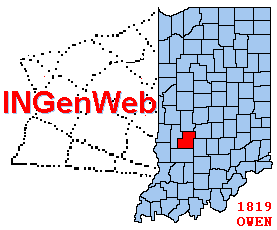Marion Township
Source: History of Owen County, James Archer, 1884
Marion Township, although opened for settlement the same year that Indiana became a state, can boast of nothing erected by civilized man which the world would call old. Thriving settlements had been made in the eastern, northern, and central parts of the country many years before any permanent home seekers ventured into the wilderness of this township, and it was not until about the year 1830 that the first pioneers began to make their appearance. In the year 1824 the first entry of land was made in the township by Mordecai Denney, a non-resident, who purchased from the Government a part of Section 1, Township 10 north, Range 6 west. The following year, lands were secured by James Stephens and Willoughby Davis neither of whom ever became residents of the township. Prior to the dates mentioned, the country had been visited at intervals by hunters and trappers, several of whom located temporarily in the vicinity of the different water-courses for the purpose of hunting game, which was abundant, and which afforded them their chief means of subsistence.
Among the earliest permanent settlers was Solomon Landreth, a North Carolinian, who settled near Marion Mills about the year 1832. Wendell Crouse came about the same time, and made an improvement not far from the former's claim, on the place owned at the present time by Abraham Funk. A little later came Gillum and Willis Reynolds who settled in the eastern part of the township, near the site of Lancaster. They were natives of the South, and enjoyed the reputation of being good citizens. William was a minister of the United Brethren Church, and one of the pioneer preachers of the township. As early as 1836 the following settlers, additional to the ones enumerated, were living in the township: Thomas Gilbert, John Lewis and his sons Zimri and Benjamin, Stewart Coats, Isom Toliver, Joseph Phipps, Clayborne Harris, Benjamin Bass, Philbert Wright, and John Fiscus. The first named settled in the northwestern part of the township, on the farm now owned by Philip Lee. Lewis located in the northeast corner of the township, not far from the site of Lancaster and seems to have been of no especial benefit to the community in which he resided.
Coats came from Ohio and settled near Lancaster, where he is still living, one of the prominent and well-to-do citizens of Marion, and the oldest settler living in the township at the present time. Toliver settled not far from Lancaster, and was not noted for any saintly qualities. Phipps settled in Section 28, where John Silvius lives. He resided here until 1858, at which time he sold out to Thomas Duncan and emigrated to one of the Western States. Harris settled in the eastern part of the township. He was noted for his enormous physical strength, and boasted of the fact that the blood of three different races flowed in his veins, i.e. the Indian, African and Anglo Saxon.
Bass settled in the eastern part of the township and is remembered as a man of many eccentricities, with but little good in his make-up. Wright made his first improvement on the farm where E. J. Miller now lives. He was a good citizen, and took an active part in ridding the country of the lawless characters, who for many years proved its curse. Fiscus came from North Carolina as early as 1820, and settled near Eel River, in Jefferson Township. He came to this part of the county in the year mentioned, since which time he has been an honored citizen of the township John McNamar came as early as 1836, and was one of the pioneer preachers of the country; his son, O'Brien came the same time, and settled with his father in the northern part of the township.
Others who became residents as early as 1837 were Edward Bass, William Bay, John Houk, Britton Burgess, Samuel Houk, Aaron Wyatt, Robert Chambers, and Barney King.
During the year 1838, the following persons were added to the population of the township, i.e. Manuel Mishler, Patrick Sullivan, the founder of Lancaster, J. M. Chambers, Robert Chambers, William Kuschner, Aaron Mitchell, S. G. Taylor, William Sparks, Luke Jennings, David Ferrill, Daniel Spurling, one of the first blacksmiths, William Sparks and others. Prominent among those who came in 1839 was John Hulet, who settled in the northwestern part of the township, where he lived until 1843, at which time he purchased land in Section 30, Township 10 north, Range 5 west, where he still resides.
Mr. Hulet was elected Justice of the Peace in an early day, and discharged the duties of his office in such a manner as to incur the ill will of a gang of outlaws, who for years made this part of the country a kind of rendezvous, and several attempts were made at different times to take his life.
These banditti, for such they really were, gave this part of the country a very unsavory reputation, and previous to Hulet's arrival all efforts to secure order proved futile, as but few persons cared to gain their enmity by trying to enforce the laws.
Hulet, however, was not a man to be intimidated, and with the assistance of a number of other persons equally determined, took the law into his own hands, and in time effectually ridded the country of the presence of the last blackleg. An early comer, whose reputation was none of the best, was Jesse Phipps, who settled on what is now the Baumgartner estate, which land he entered as early as 1833. He was a man of considerable property, and kept a house which for a number of years was the general resort of a class of roughs who set at defiance the laws of both God and man. He had three grown sons, i.e. Mashach or "Shack", Shadrach and Troy, all three of whom gained considerable notoriety on account of their many daring acts of lawlessness. Another man of the same ilk was Owen Long, who settled in the northwestern part of the township a little later. His sons, Aaron and John, were noted desperadoes, and were afterward hung for the murder of Col. Davenport, a prominent citizen of Rock Island, Ill.
Jefferson Long, a relative of the preceding, and S. G. Taylor, a son-in-law of Jesse Phipps became residents in an early day, and outside of their immediate associates were but little respected in the community. Other settlers came in from time to time and by the year 1850 the township was tolerably well populated and all the Government land taken up and occupied.



